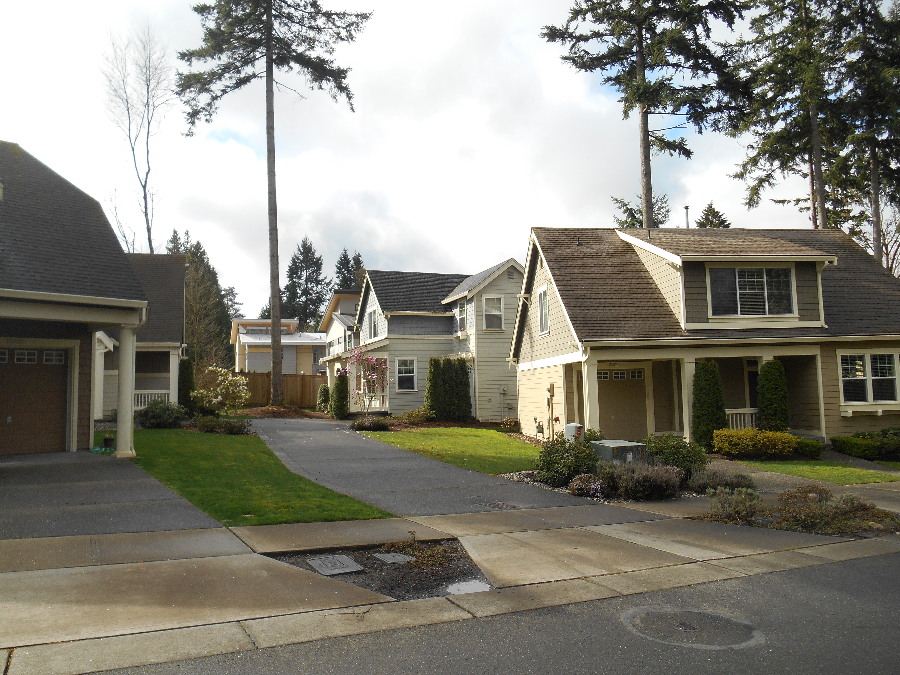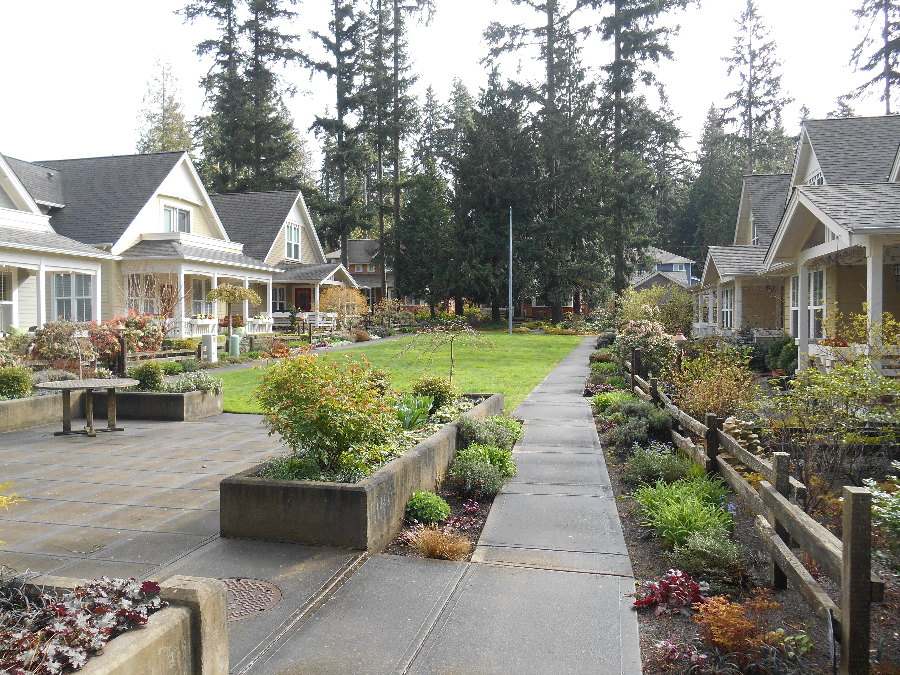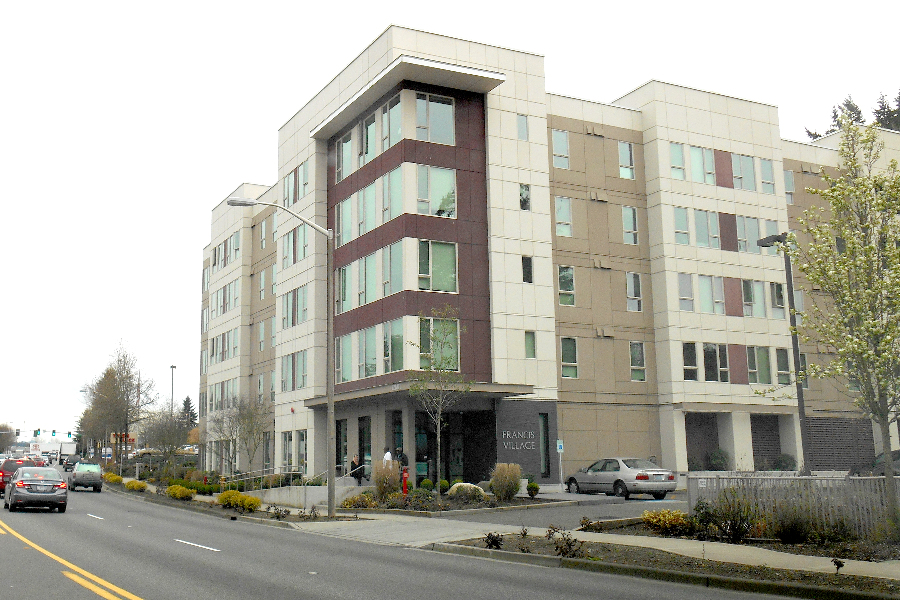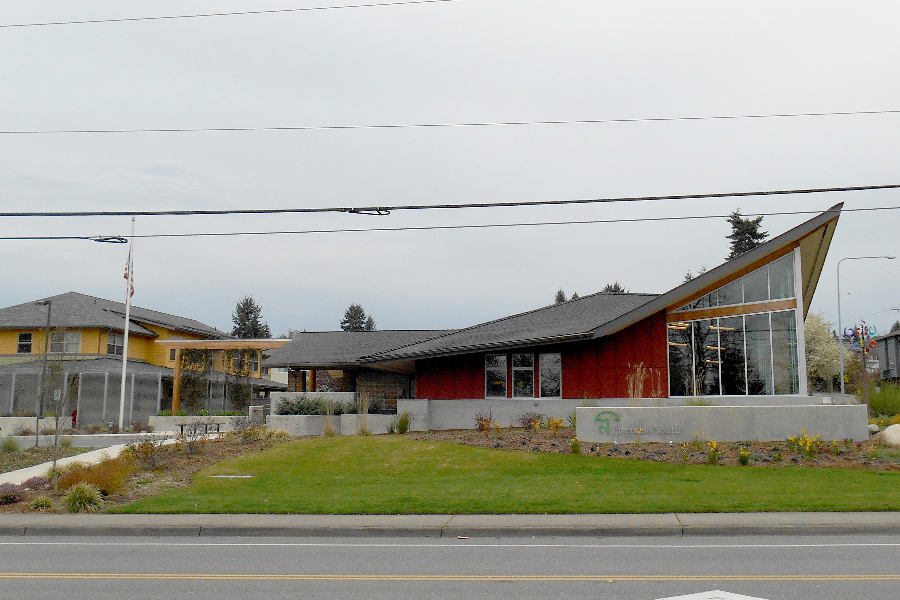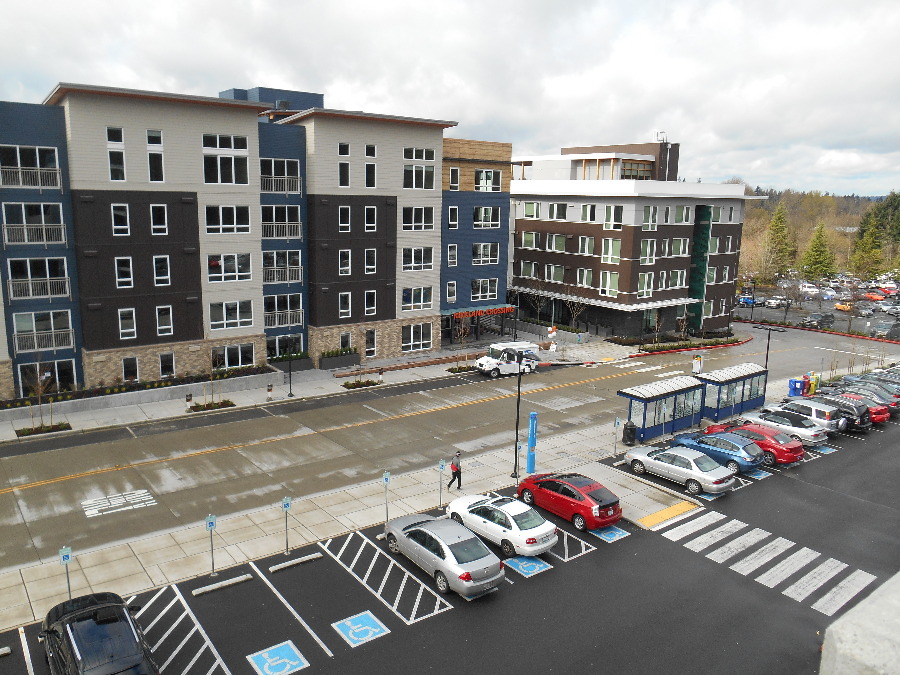C. Housing Goals
|
Goal H-1: Maintain and enhance the unique residential character of each City neighborhood. |
|
Goal H-2: Ensure that Kirkland has a sufficient quantity and variety of housing to meet projected growth and needs of the community. |
|
Goal H-3: Promote affordable and special needs housing throughout the City for all economic segments of the population. |
Neighborhood Quality
As the Vision Statement and Framework Goals describe, Kirkland’s citizens consider the preservation and enhancement of neighborhoods to be strong community values.
Kirkland encompasses many distinct neighborhoods that can be differentiated on the basis of density, age of structures, size of detached homes or multifamily structures, and a variety of visible features. The City’s neighborhoods, with their own unique residential characters, offer a choice of living environments. This diversity adds to the community’s ability to meet a wide variety of residential needs.
The following goals and policies are designed to ensure that new development meets the high standards for livability of Kirkland neighborhoods, and that the preferred community character is preserved.
Goal H-1: Maintain and enhance the unique residential character of each City neighborhood.
Policy H-1.1: Incorporate neighborhood character and design principles into standards for new development.
Because change will take place in all neighborhoods between 2015 and 2035, design standards for new development will be important to the preservation of neighborhood quality. Standards should address how new development, particularly when sited on smaller lots or at greater densities than surrounding development, can occur in a manner compatible with existing neighborhood character.
These standards can encourage structures to integrate sensitively with the surrounding area by addressing issues such as scale and bulk, setbacks which reinforce those of surrounding residences, as well as landscape buffers where appropriate.
Housing Diversity
This Element contains policies designed to support opportunities to respond to the market and provide an adequate supply and variety of housing.
Housing Variety
A variety of housing types is essential if Kirkland is to meet the needs of the diverse households that want to live in the community. For example, nearly two-thirds of households in Kirkland in 2014 have just one or two people. Kirkland has a relatively large percentage of younger adults (ages 20 to 44) and a relatively small percentage of families with school-age children. In 2014, senior citizens comprise almost one-quarter of the population, and could double in number within 20 years. In addition, 20 percent of Kirkland’s residents were born outside the United States, a population which is also growing rapidly. These are examples of demographics whose housing needs may require a different mix of housing types over time than the City presently has.
Kirkland Bungalows
Danielson Grove cottage housing
Housing Supply
At an average density of 6.0 dwelling units per residential acre Citywide, Kirkland’s residential densities are higher compared to other suburban communities. Nevertheless, the City contains many neighborhoods developed at lower densities (three to five dwelling units per acre). In 2013, Kirkland had 36,866 housing units, capacity for an additional 9,516 units, and a 2035 Growth Target of 8,361 units.
As noted in the Housing Diversity section of this Element, greater opportunities for home ownership may be created through smaller lots and more varied housing types. In addition, cost savings are generally associated with smaller lots and revised development standards. The savings obtained through reducing the amount of street, sidewalk, water, sewer, and other utilities needed for each home may be reflected in the initial purchase price as well as ongoing maintenance and services costs to both the home owner and the public.
Goal H-2: Ensure that Kirkland has a sufficient quantity and variety of housing to meet projected growth and needs of the community.
Policy H-2.1: Maintain an adequate supply of land zoned appropriately for a variety of housing types and densities.
As Kirkland has become more fully developed in recent years, residential development trends have included a shift away from large subdivisions to “infilling” of vacant and underdeveloped lots within existing neighborhoods.
About two-thirds of the City’s remaining residential capacity exists in mixed-use areas, with the expectation of moderate-to-high housing densities mixed with commercial uses. In the Totem Lake and Lakeview areas, future development would be largely separated from single-family areas, while in Rose Hill, some of the new housing will transition between businesses on NE 85th Street and surrounding single-family homes.
The City already allows slight reductions from the required single-family lot sizes as one method to accommodate more housing on existing residential land while helping to avoid suburban sprawl. Further lot size reductions would increase capacity in areas already served by transit and other public utilities and services. This should only be considered where compatibility with surrounding neighborhoods can be ensured through site and building design and house sizes will be reduced to be in scale with smaller lot sizes.
Policy H-2.2: Promote the development of accessory dwelling units on single-family lots.
Accessory units are promoted as a means to achieve a different form of housing that is also relatively affordable in existing neighborhoods by more efficiently using the existing housing stock. Regulatory guidelines should minimize procedural requirements, but should address neighborhood compatibility.
Income from these units can help residents in a variety of situations, as well as help to preserve the City’s existing housing through supplementing upkeep costs, thereby extending the livability of a dwelling. Since adoption of regulations in 1995 to allow accessory dwelling units, as of 2014 over 190 units have been created within existing houses, over detached garages and in separate structures.
Policy H-2.3: Create flexible site and development standards, and maintain efficient development and review systems, that balance the goals of reduced housing development costs with other community goals.
Site and development standards affect many direct development costs, such as infrastructure, land, and building costs. Street widths, setbacks, curb and sidewalk requirements, and parking standards are some of the residential standards that may affect costs. Standards that allow alternative approaches to site and building design may provide cost savings as well as respond to emerging needs of the market. Some combination of a prescriptive standard that is permitted outright and an optional performance standard may be desirable to balance the desire to minimize costs and maintain quality. In addition, manufactured housing can produce high quality housing that is less costly to construct than site built housing. Land use regulations should be applied equally to manufactured and site built housing.
Since time is a critical factor in financing development projects, a reduction in the time needed to receive City approval can result in savings to housing providers. Adding certainty to the development review process will also facilitate residential development.
Policy H-2.4: Allow a broad range of housing and site planning approaches in single-family areas to increase housing supply and choice, to reduce cost, and to ensure design quality and neighborhood compatibility.
Clustering and innovative housing types may include cottages, compact single-family, zero lot line, clustered and common wall housing. These development styles can allow for more environmentally sensitive site planning by concentrating development on the most buildable portion of a site while preserving natural drainage, vegetation, and other natural features. Similarly, allowing zero lot line or other design innovations in these areas can further help to lower land and development costs.
Innovative housing types also may be appropriate on sites in single-family neighborhoods that do not have environmental constraints. The demographics of our population are changing, with the average number of people living in each housing unit decreasing and the average age increasing. Cottage, compact single-family and common-wall housing can provide more housing on the same land area, in smaller structures that better match the needs of our population. In addition, housing affordability can be improved through reduced construction costs resulting from smaller or common-wall development.
In all cases, design standards are important to ensure that new development is integrated sensitively with its neighbors. Greater attention to building and site design, such as building bulk, roofline variation, garage and parking location, and landscaped buffers can enhance aesthetic appeal and neighborhood compatibility.
Policy H-2.5: Allow for the maintenance and redevelopment of existing developments that do not conform to current density standards in planned multifamily areas.
A number of multifamily structures in the City were built at densities above those now planned for their sites. These structures provide a valuable source of close-in and often relatively affordable housing to Kirkland residents. In order to retain the housing capacity provided by these units, property owners should be allowed to maintain, remodel, or rebuild these structures, while retaining their existing densities.
Affordable and Special Needs Housing
Housing Affordability
These policies strive to improve housing affordability at all income levels, and emphasize a combination of appropriately zoned land, regulatory incentives, financial subsidies, and innovative planning techniques, in order to ensure that moderate-, low- and very low-income households have adequate housing opportunities. Housing for these households is least likely to be provided by the private housing market.
Household and affordable housing counts within each of the defined income groups (based on King County’s median income) in 2011 were as follows:
|
Income or Affordability Level ($ in 2011) |
Percent of Kirkland’s Households by Income |
Percent of Kirkland’s Housing Units by Affordability |
|---|---|---|
|
Very Low-Income (<30% of median income; or $21,200) |
8% |
2% |
|
Low-Income (30% – 50% of median; $21,200 to $35,300) |
8% |
4% |
|
Moderate-Income (50% – 80% of median; $35,300 to $56,500) |
14% |
16% |
|
Middle-Income (80% – 100% of median; $56,500 to $70,599) |
9% |
19% |
|
Above Middle-Income (greater than $70,599) |
61% |
59% |
About 30 percent of the City’s households fall within the very low-, low- and moderate-income categories. This is about the same proportion as in 2000, although the percentages in upper-income categories have been growing since 1990. Including the annexation of some 8,000 households in Finn Hill, North Juanita, and Kingsgate, the percentage of middle-income households dropped three points (from (12 percent) and the percentage of above-middle-income households increased four points (from 57 percent).
The vast majority of housing affordable to low- and moderate-income families in Kirkland, as in most communities, is rental housing, typically multifamily. As shown in Table 2, below, most of the City’s rental housing is affordable to moderate-income families, including about 16 percent that is also affordable to low-income families; and yet 76 percent of moderate- or lower-income renters are housing cost burdened; that is, pay more than 30 percent of their incomes toward housing costs. As households overpay to this extent, they may be forced to forgo other necessities, or be unable to save to buy homes because their housing expenses consume such large portions of their incomes.
Francis Village
|
Income or Affordability Level |
Percent of Kirkland’s Renters by Income |
Percent of Kirkland’s Rental Housing Units by Affordability |
Kirkland’s Renters, by Income, Who Are Cost-Burdened |
|---|---|---|---|
|
Very Low-Income |
14% |
7% |
72% |
|
Low-Income |
12% |
9% |
80% |
|
Moderate-Income |
14% |
43% |
68% |
|
Middle-Income or Above |
60% |
41% |
22% |
Roughly 60 percent of Kirkland’s very low-income households are severely cost burdened; i.e., pay more than 50 percent of their incomes for housing. The higher percentage of income paid toward housing, the more vulnerable a household is to actually losing their housing if someone in the household loses a job, suffers a medical emergency, or incurs some other major expense. As a result, these households may become homeless, displaced, or reside in overcrowded or substandard housing.
Special Needs Housing
Special needs housing provides shelter for people with emergencies or self-help limitations. Short-term special needs housing is needed to provide shelters for victims of domestic violence or homeless families, for example. Long-term housing with appropriate supportive services, such as single-family homes shared by adults with developmental disabilities, apartments adapted to serve the frail elderly, or efficiency units for the mentally ill, are also needed to prevent homelessness.
Friends of Youth
The City should consider funding, technical assistance, and additional flexibility to land use regulations as needed to provide a greater range of special needs housing. In particular, state law provides that homes occupied by people with disabilities and group care for children that meets the definition of “familial status” are regulated the same as similar homes occupied by a family or other unrelated individuals. Other policies show Kirkland’s commitment to collaborate with other jurisdictions to plan and support a balance of special needs housing and programs throughout the region, particularly to relieve and prevent homelessness.
Goal H-3: Promote affordable and special needs housing throughout the City for all economic segments of the population.
Policy H-3.1: Strive to meet the City’s proportionate share of the Countywide housing needs of very low-, low-, and moderate-income households.
The goals established by the Countywide Planning Policies maintain that cities, including Kirkland, address the Countywide housing need, in proportion to the City’s own size, at the following income levels:
|
Income or Affordability Level for a Family of Four |
Percent of King County’s Households by Income |
Percent of Kirkland’s Housing Units by Affordability |
|---|---|---|
|
Very Low-Income |
12% |
2% |
|
Low-Income |
12% |
4% |
|
Moderate-Income |
16% |
16% |
|
Middle-Income |
18% |
19% |
|
Above Middle-Income |
42% |
59% |
As the table demonstrates, these goals have proven challenging to meet for low- and very low-income households. While market conditions and existing plans have been fairly successful in providing rental housing for moderate-income households, low-income households have not been well served by either the rental or home ownership markets.
Special incentives for the development of low- and moderate-income housing should be used as a means to promote the provision of these units by private or nonprofit developers. Kirkland’s existing programs that provide density bonuses for affordable housing could be expanded, and other types of incentives also should be explored. As a member of ARCH, as mentioned in the Introduction, the City has assistance to carry out many of the policies of the Housing Element.
Because every city has its own circumstances, limitations, and opportunities, Kirkland can and should support affordable housing across the Eastside as well as within the community. As a member of ARCH, as mentioned in the Introduction, the City has assistance to carry out many of the policies of the Housing Element.
Policy H-3.2: Require affordable housing when increases to development capacity are considered.
Rezones, height and bulk modifications, and similar actions often yield greater development capacity. This can add significant value for property owners and an opportunity to create affordable housing with minimal (if any additional) cost to the owner. When the City considers amendments to the Comprehensive Plan, Zoning Code, or other regulations, the City should compare the economic value of the increased capacity to the economic cost of providing affordable units and decide whether to require affordable housing in return.
Policy H-3.3: Ensure that affordable housing opportunities are not concentrated, but are available throughout the City and especially in areas with good access to transit, employment, and shopping.
The bulk of housing affordable to low- and moderate-income households is multifamily. Nevertheless, opportunities for affordable housing, and special-needs housing, may occur in single-family neighborhoods through infill, accessory units, or group homes. These housing options should be available throughout the community and integrated into neighborhoods. This distribution will ensure a wider range of housing options for Kirkland residents.
Policy H-3.4: Preserve, maintain, and improve existing affordable housing through assistance to residents and housing providers.
Due to the high relative land values prevailing in the City, and the resulting difficulty that developers face in producing new housing that meets the needs of low- and moderate-income residents, assistance to enable rehabilitation of existing housing may be one of the most effective strategies to maintain and produce affordable housing in Kirkland. Another benefit of rehabilitation is that it is less likely to change the appearance of neighborhoods.
The City’s Housing Repair program supports the preservation of both the owner-occupied and rental housing stock through grants and loans for housing repair and rehabilitation. Community Development Block Grant (CDBG) funds and City funds are also allocated to housing providers to acquire and rehabilitate emergency and transitional housing facilities, as well as permanent low- and moderate-income housing development and homeownership programs.
Policy H-3.5: Support housing acquisition and creation by private or nonprofit organizations, housing authorities, or other social and health service agencies for very low-, low- and moderate- income residents.
Local resources can be a critical part of developing or preserving affordable housing. Surplus public property, Community Development Block Grant (CDBG) and City general funds invested through the ARCH trust fund, and payments or waivers of fees and infrastructure costs all have potential to improve the feasibility of affordable housing projects.
South Kirkland Park and Ride Lot Housing
This is especially true of housing for individuals and families who cannot afford housing created through the private market. Local resources are often required as a match for other public and private funding sources, and leverage a significant amount of funding into Kirkland and the region that would otherwise not be available.
The City can also support affordable housing acquisition and development in indirect ways:
• Working with local lenders to coordinate financing for projects.
• Encouraging private and other public donation of resources.
• Inventorying multifamily residential properties and encouraging preservation of those that are affordable.
• Working with the legislature to fund the state’s housing trust fund, to provide additional tax relief, and to authorize additional tools for local governments.
Policy H-3.6: Ensure that regulations do not unduly restrict group homes or other housing options for persons with special needs.
Special-needs housing can be provided in single-family homes, group homes, multifamily dwellings, congregate care facilities, and other settings. Regulating group homes and home-based care as other housing represents a significant opportunity available to the City to meet the demand for special needs housing. Barriers to creating these housing options, including extensive special review processes, should be avoided.
Policy H-3.7: Support a range of housing options and services to move homeless persons and families to long-term financial independence. Support regional efforts to prevent homelessness.
A variety of housing types – shelters, single-room occupancy hotels (SROs), group homes, congregate care facilities – are needed to combat homelessness. The City should continue to make funding available to social service agencies serving these special-needs populations, to facilitate their development and operation.
The City should also work cooperatively with nonprofit agencies or the private sector to site special-needs housing while helping neighbors to understand the role of special needs housing in the community and the requirements of the federal and state fair housing laws. The (King County) Committee to End Homelessness and other regional efforts are creating a more integrated system for addressing homelessness. This work guides local efforts in supporting work with specific programs and agencies.
Policy H-3.8: Cooperate at a regional level to increase the base of both public and private support necessary to address local housing needs.
Communities within King County should work together to address shared housing needs, since housing needs and solutions cross jurisdictional boundaries. They should cooperate on a regional housing finance strategy that complements local funding efforts and allows sharing resources to support affordable and special needs housing throughout east King County.
Policy H-3.9: Support housing options, programs, and services that allow seniors to stay in their homes or neighborhood. Encourage universal design improvements that increase housing accessibility.
Universal design refers to a broad spectrum of ideas meant to produce products, buildings, or other built environments that are useable to the greatest extent possible by everyone, regardless of their age, ability, or status in life. Wheelchair ramps, essential for people in wheelchairs but also used by all, are a common example. There are also cabinets with pull-out shelves, kitchen counters at several heights to accommodate different tasks and postures, and many other features.
Policy H-3.10: Support efforts to achieve a geographic balance in siting special-needs housing throughout the City and region, including support of housing in jurisdictions that serve residents from elsewhere on the Eastside.
Generally, special needs housing should be available throughout the region. Some clustering of special needs housing may be appropriate when proximity to public transportation, medical facilities, or other basic services is necessary.
Funds invested by Kirkland to provide this type of housing should be considered for projects both in Kirkland and elsewhere on the Eastside. Similarly, projects serving special needs populations are funded by Bellevue, Redmond, and other Eastside communities should be sited in Kirkland when appropriate.
Policy H-3.11: Protect fair and equal access to housing for all persons and prohibit any activity that results in discrimination in housing.
Fair housing is the ability for all people to choose where they live without discrimination based on race, color, national origin, sex, family status, or disability. These are the “protected classes” under state and federal law. Kirkland also protects people from rental housing discrimination on the basis of using a Section 8 voucher to help pay their rent. Cities may not make zoning or land use decisions or implement policies that exclude or otherwise discriminate against protected persons. Periodically, King County conducts an Analysis of Impediments to Fair Housing (a Countywide report to the federal government), which can be a resource to Kirkland’s fair housing practices.



